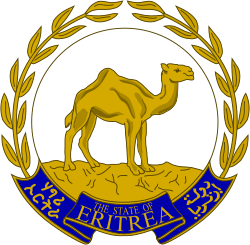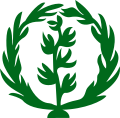Emblem of Eritrea facts for kids
Quick facts for kids Emblem of Eritrea |
|
|---|---|
 |
|
| Armiger | State of Eritrea |
| Adopted | 24 May 1993 |
| Blazon | Argent, a base of sand or, overall a camel of the same |
| Supporters | An olive wreath |
| Motto | ሃገረ ኤርትራ (Tigrinya) The State of Eritrea (English) دولة إرتريا، (Arabic) |
The national emblem of Eritrea is a special symbol for the country. It was chosen on May 24, 1993. This date was when Eritrea officially became independent from Ethiopia. The emblem mainly shows a camel surrounded by a wreath of olive branches.
Eritrea's Current Emblem
The current emblem of Eritrea was adopted on May 24, 1993. This was the day Eritrea declared its independence from Ethiopia. The emblem shows a dromedary camel in a desert scene. This scene is surrounded by an olive wreath.
The camel was very important during Eritrea's fight for independence. It was used to carry supplies and goods. Many Eritreans saw the camel as key to their success. At the bottom of the emblem, the country's name appears on a scroll. It is written in three languages: Tigrinya, English, and Arabic. These are widely spoken languages in Eritrea.
History of Eritrea's Emblems
Eritrea first received a coat of arms in 1919. At that time, it was a colony of the Kingdom of Italy. The shield was split into two parts. The top part showed a red lion with a white star on its chest. The bottom part had six wavy blue and white stripes.
The red lion stood for the Italian Kingdom. Lions were often used by Italian kings. Red was a common color for Italy and its ruling family. The star, called the Stellone d'Italia, was a long-time symbol for the Italian people. It was seen as protecting the nation. The blue and white wavy stripes represented water. They hinted at how the colony got its name. Eritrea comes from the Latin word Erythræa. This was an old name for the Red Sea. The colony was named for its coastline along this sea.
During a specific period of Italian history, starting in 1924, the arms changed. In 1936, new symbols were added to the top. These included a red section with a bundle of rods and an olive wreath. Eritrea then became part of a larger colony called Italian East Africa in 1936. Eritrea's arms became one part of the larger colony's emblem.
In 1941, British forces took control of Eritrea. The added symbols were removed. The original arms were used again. In 1951, Eritrea began to be joined with Ethiopia. The arms continued to be used until 1952.
From 1952 to 1962, during the time Eritrea was joined with Ethiopia, a new emblem was used. This emblem had a vertical olive branch. It was surrounded by an olive wreath. This specific emblem is still used today on the nation's flag.
Images for kids
See also
 In Spanish: Escudo de Eritrea para niños
In Spanish: Escudo de Eritrea para niños




